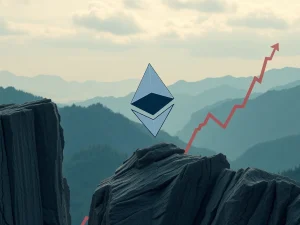Shocking: Average Ethereum ETF Investor Substantially Underwater, Glassnode Reports

For many investors jumping into the world of cryptocurrency via traditional investment vehicles, the ride hasn’t been smooth lately. According to recent data from crypto analytics firm Glassnode, the average investor in major spot Ethereum ETF products is currently facing substantial unrealized losses.
What are Average Ethereum ETF Investors Facing?
Glassnode’s May 29 report highlights a challenging situation for those who bought into BlackRock and Fidelity’s spot Ether ETFs. The data indicates that the average investor in these funds holds an unrealized loss of approximately -21% on their position. This means the current market value of their investment is significantly lower than their average purchase price.
Let’s look at the numbers:
- Glassnode’s report date: May 29
- Average unrealized loss for BlackRock/Fidelity ETF investors: ~-21%
- ETH price around report time (CoinMarketCap): $2,601
- BlackRock’s average cost basis for its ETF: $3,300
- Fidelity’s average cost basis for its ETF: $3,500
These figures show a clear discrepancy between the current ETH price and the price points at which the average ETF shares were acquired.
Why are Investors Underwater?
The primary reason investors are currently underwater relates directly to the purchase price relative to the current market value. BlackRock’s spot Ether ETF buyers, on average, acquired shares when Ether was around $3,300, while Fidelity buyers had an even higher average cost basis of $3,500. Ether has spent significant time trading below these levels since these ETFs launched.
External market factors have also played a role. The article notes a downtrend occurred after US President Donald Trump signed an executive order related to import tariffs. While Ether has seen a recent surge, climbing over 44% in the past month, this rally hasn’t been enough to bring the average ETF investor back into profit, given their higher entry points.
Glassnode’s Insights on ETF Impact
Crypto analytics firm Glassnode also provided context on the overall impact of these ETFs on the spot market. Initially, they accounted for only about 1.5% of spot market trade volume, suggesting a relatively modest reception upon launch in July 2024 (when Ether was trading around $3,536).
Volume saw a temporary increase to over 2.5% in November 2024, coinciding with a broader crypto market rally. However, this measure has since declined back towards 1.5%, indicating that while total inflows have reached $2.94 billion since launch, the daily trading volume contribution from these ETFs remains relatively small compared to the overall spot market.
ETF Flows and Market Sentiment
Despite the average investor being underwater, spot Ether ETFs have recently seen positive momentum. They recorded nine consecutive days of inflows totaling $435.6 million since May 16. This suggests renewed interest or potentially buying at lower price points by some investors, even as the average position remains at a loss.
The last net outflow day for US spot Ether ETFs was May 15. This shift in flow could be influenced by changing market sentiment, potentially related to factors like the US federal court blocking some tariffs, which analysts believe could support the crypto market.
Challenges and Future Outlook
The data from Glassnode highlights the volatility inherent in crypto investments, even when accessed through traditional ETF structures. The high average cost basis for early buyers of BlackRock and Fidelity products demonstrates that timing the market remains challenging.
Furthermore, discussions around the structure of these ETFs continue. BlackRock’s head of digital assets, Robbie Mitchnick, noted in March that a spot Ether ETF is ‘less perfect’ without staking yield potential, a feature currently unavailable in the approved US products.
While the recent inflows and market rally offer some optimism, the current unrealized losses for the average investor underscore the risks involved. Future market movements and regulatory developments will likely dictate when, or if, these early ETF investors will see their positions return to profitability.
Summary
In conclusion, while spot Ethereum ETFs have attracted billions in inflows since their launch, the average investor in products from BlackRock and Fidelity is currently facing significant unrealized losses, around 21% on average, according to Glassnode. This is largely due to their average purchase price being substantially higher than the current ETH price. Despite recent positive inflows into the ETFs and a rally in Ether’s price, the path to profitability for these investors depends heavily on future market performance and could be influenced by broader economic and regulatory factors.









